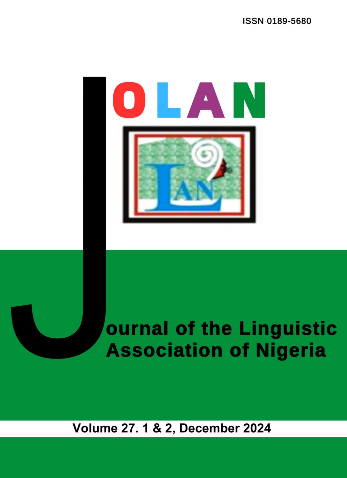Imperative clauses in the Ìyàgbà dialect of Yorùbá
Keywords:
Imperative CP-hypothesis Politeness ÌyàgbàAbstract
Imperative clauses express commands, orders, instructions or directives. Extant studies recognise imperative clauses as sub-units of sentences on the basis of function-based criterion with little attention paid to the details about the structure, derivation and clause-mood indicating mechanism of the discourses. This present study therefore, provides a theoretically-based description of the structure, derivation and the exertion of illocutionary force of imperative clause. The theoretical orientation adopted is the Minimalist Program and Rizzi’s split CP-hypothesis. The ethnographic design was used. The database comprises a structured interview guided by the Ibadan Syntactic Paradigm and the Ibadan 400 wordlist. The investigation purposively selected and interviewed five competent native speakers whose ages range between 40 and 70 from the Ìsánlú variety of Ìyàgbà. The collected data were subjected to interlinear glossing, qualitative and syntactic analyses. It is observed that the imperative clauses of Ìyàgbà can be classified into direct and indirect imperative clauses. The markers of both imperative clauses are covert. The purported markers (i.e. je /̣́kí ‘let’) of indirect imperative sentences are re-analysed as politeness markers that license their Determiner Phrases for politeness. The two types of imperative clauses can therefore be differentiated by [+ Politeness] and [-Politeness] for indirect and direct imperative clauses respectively. The negators employed in imperative utterances are mo ̣́ and ra ‘do not’. The hierarchical order of clausal structure that appropriately captures imperative discourses of Ìyàgbà is proposed as: ImpP>(PolP)>(NegP)>TP>vP>VP
References
Adéle ̣́yẹ, I.O. (2008) “Relativisation and question formation processes in O ̣́ wo ̣́ dialect”. An unpublished B.A. Essay of the Department of Linguistics and Nigerian Languages, Adekunle Ajasin University, Akungba Akoko, Ondo State
Adéjùbe ̣́e , S. (2020) The basic clause in Yor ̣́ ùbá-Ìyàgbà dialect of Kogi State, Nigeria. PhD thesis, Department of Linguistics and African Languages, University of Ìbàdàn, Nigeria.
Adger, D. (2003) Core syntax: a minimalist approach. Cambridge: CUP.
Awóbùlúyì, O. (1978) Essentials of Yorùbá grammar. Ibadan: OUP.
Awóbùlúyì, O. (2013) E ḳ́ o ̣́gírámà èdè Yorùbá. Òṣogbo: Atman Limited.
Bámgbóṣé, A. (1990) Fono ḷ́ọji àti gírámà Yorùbá. Ibadan: UPL.
Bámgbóṣé, A. (1986 Reprinted) A short Yorùbá grammar. Ibadan: HEB. Ltd.
Chomsky, N. (1995) The minimalist program. Cambridge. Mass: MIT.
Chomsky, N. (1998) Minimalist inquiries: The framework, MIT occasional papers. MIT press: MA.
Haegeman, L. and Lohndal, T. (2011) Review article: Introducing minimalist program to students of English.”
Hornstein, N., Nunes, J. and Grohmann, K. K.( 2005) Understanding minimalism: CUP.
Okùnadé, B: (1992) “Oríṣi e ỵ́ ạ gbólóhùn Yorùbá: Gbólóhùn asèbéèrè.” YORÙBÁ GBÒDE. Ìwé àtìgbàdégbà ti Ẹgbe ̣́ Ako ̣́mọlédè àti Àṣà Yorùbá ile ̣́Nàìjíríà. Fo ̣́lúùmù k in-ín-ní, no ̣́ńbà ke ̣́jọ.
Quirk, R. and Greenbaum, S. (2012 7th impression) A university grammar of English. India: India Binding House.
Rizzi, L. (1997) “The fine structure of the left periphery,” Haegeman, L. (Ed.). Cambridge: CUP.
Rizzi, L (2001) “On the position “interrogative in the left periphery of the clause”. Cinque, G. Eds. Current issues in Italian: Elsevier, Amsterdam.
Rizzi, L (2004) “The structure of CP and P. The cartography of syntactic structures”. Vol. 2. Oxford: OUP.














